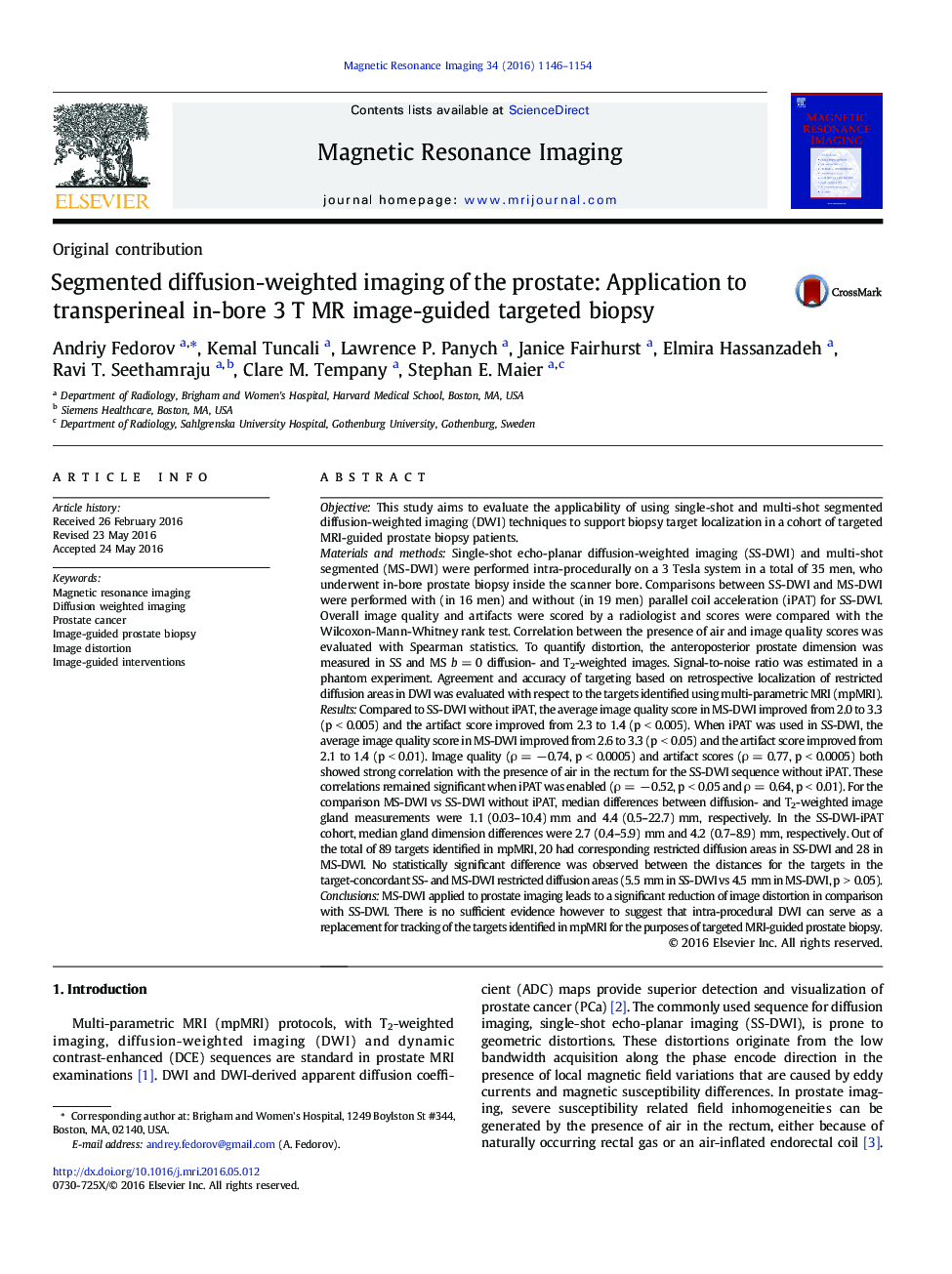| کد مقاله | کد نشریه | سال انتشار | مقاله انگلیسی | نسخه تمام متن |
|---|---|---|---|---|
| 1806120 | 1025185 | 2016 | 9 صفحه PDF | دانلود رایگان |

ObjectiveThis study aims to evaluate the applicability of using single-shot and multi-shot segmented diffusion-weighted imaging (DWI) techniques to support biopsy target localization in a cohort of targeted MRI-guided prostate biopsy patients.Materials and methodsSingle-shot echo-planar diffusion-weighted imaging (SS-DWI) and multi-shot segmented (MS-DWI) were performed intra-procedurally on a 3 Tesla system in a total of 35 men, who underwent in-bore prostate biopsy inside the scanner bore. Comparisons between SS-DWI and MS-DWI were performed with (in 16 men) and without (in 19 men) parallel coil acceleration (iPAT) for SS-DWI. Overall image quality and artifacts were scored by a radiologist and scores were compared with the Wilcoxon-Mann-Whitney rank test. Correlation between the presence of air and image quality scores was evaluated with Spearman statistics. To quantify distortion, the anteroposterior prostate dimension was measured in SS and MS b = 0 diffusion- and T2-weighted images. Signal-to-noise ratio was estimated in a phantom experiment. Agreement and accuracy of targeting based on retrospective localization of restricted diffusion areas in DWI was evaluated with respect to the targets identified using multi-parametric MRI (mpMRI).ResultsCompared to SS-DWI without iPAT, the average image quality score in MS-DWI improved from 2.0 to 3.3 (p < 0.005) and the artifact score improved from 2.3 to 1.4 (p < 0.005). When iPAT was used in SS-DWI, the average image quality score in MS-DWI improved from 2.6 to 3.3 (p < 0.05) and the artifact score improved from 2.1 to 1.4 (p < 0.01). Image quality (ρ = − 0.74, p < 0.0005) and artifact scores (ρ = 0.77, p < 0.0005) both showed strong correlation with the presence of air in the rectum for the SS-DWI sequence without iPAT. These correlations remained significant when iPAT was enabled (ρ = − 0.52, p < 0.05 and ρ = 0.64, p < 0.01). For the comparison MS-DWI vs SS-DWI without iPAT, median differences between diffusion- and T2-weighted image gland measurements were 1.1 (0.03–10.4) mm and 4.4 (0.5–22.7) mm, respectively. In the SS-DWI-iPAT cohort, median gland dimension differences were 2.7 (0.4–5.9) mm and 4.2 (0.7–8.9) mm, respectively. Out of the total of 89 targets identified in mpMRI, 20 had corresponding restricted diffusion areas in SS-DWI and 28 in MS-DWI. No statistically significant difference was observed between the distances for the targets in the target-concordant SS- and MS-DWI restricted diffusion areas (5.5 mm in SS-DWI vs 4.5 mm in MS-DWI, p > 0.05).ConclusionsMS-DWI applied to prostate imaging leads to a significant reduction of image distortion in comparison with SS-DWI. There is no sufficient evidence however to suggest that intra-procedural DWI can serve as a replacement for tracking of the targets identified in mpMRI for the purposes of targeted MRI-guided prostate biopsy.
Journal: Magnetic Resonance Imaging - Volume 34, Issue 8, October 2016, Pages 1146–1154